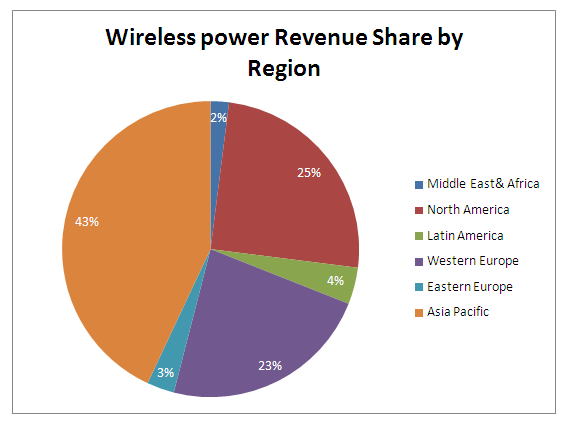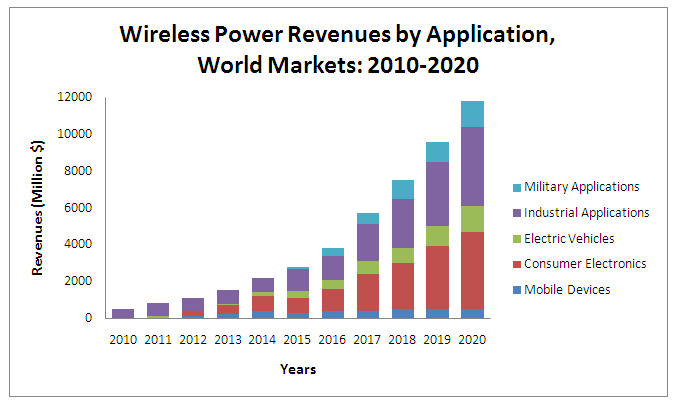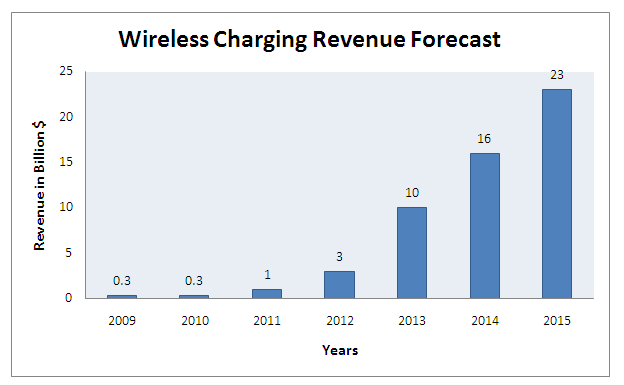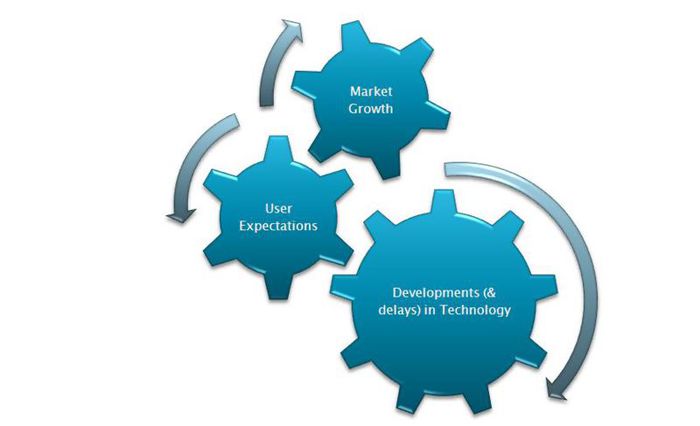Difference between revisions of "Wireless Power Transmission"
Amika.sethi (Talk | contribs) (→Wireless Power Applications) |
|||
| Line 135: | Line 135: | ||
<br/> | <br/> | ||
| − | + | ||
| − | + | ||
| − | + | ||
==Sources== | ==Sources== | ||
Latest revision as of 18:18, 31 July 2011
Contents
Introduction
Wireless transmission of power, also called wireless power transfer (WPT), is a means of delivering power to an end-use device without wires or contacts. As wireless data transmission eliminates the need for wires to carry data, there is a growing need to find ways to provide power without wires making devices truly portable and mobile. With the explosive growth in wireless data applications, the market potential for wireless energy transfer technologies has seen a dramatic increase.
It is the latest technology for direct powering and wireless charging of cell phones, game controllers, laptop computers, mobile robots, electric vehicles, Flat screen TV’s and digital picture frames that hang on the wall—without requiring a cord or an adaptor. Industrial systems and medical devices made more reliable by eliminating trouble prone wiring and replaceable batteries.
Benefits of WPT
Convenience and cost
- An alternative to the existing high-tension power transmission line cables, towers and sub stations between the generating station and consumers.
- Can facilitate the interconnection of electrical generation plants on a global scale.
- The cost of transmission and distribution can become less thereby reducing the cost of electrical energy for the consumer.
- The power can be transmitted to the places where the wired transmission is not possible.
- Loss of transmission is negligible level in the Wireless Power Transmission; therefore, the efficiency of this method is very much higher than the wired transmission.
- No risk of power failure due to short circuit and fault on cables.
- Power theft also not possible.
- With the development and implementation of WPT charging system, the manufacturing cost of consumer devices can be reduced because the chargers will then become integral parts due to the integrated WPT receivers.
- The WPT integrated devices will provide ultimate convenience to the community as there will be no need of chargers and the use of cables and power cords will be reduced.
Enabling new technologies
- Even mobile transmitters and receivers can be chosen for the WPT system.
- WPT enabled devices will give better mobility because the battery capacity will not be a critical issue to the manufacturer.
- Smaller and lighter cell packs are applicable resulting in further reduction in product size and weight.
- Apart from that, WPT enabled devices can have greater expandability as multi-power outlets since a single transmitter can transmit power to multiple receivers within the coverage area without additional hardware.
Clean technology
- With increased efficiency in transmission of electricity, the pollution levels caused due to thermal generation of power are also likely to come down with the onset of the WPT technology
- Reducing the need for copper-wire transmission grids
- Transporting power from remote generation sources, such as wind farms and solar arrays
- Collecting and using micro-power from ambient sources, such as cellular networks, that otherwise dissipates – a technique known as “power harvesting”
- Replacing costly and carbon-intensive electricity sources, such as diesel generators, in temporary applications and locales
Categories and Classification
By Technology
- Magnetic Resonance
Employs near field inductive coupling through magnetic fields, which interact far more weakly with surrounding objects, including biological tissue. This technology had not been developed much. Researchers attribute it to various reasons ranging from the limitations of well-known physical laws, to simply a lack of need. - Inductive Coupling
Inductive coupling, the most developed form of WPT, operates in the lowest region of the electromagnetic spectrum. It uses magnetic fields that are a natural part of current's movement through¬ wire. Any time electrical current moves through a wire, it creates a circular magnetic field around the wire. Bending the wire into a coil amplifies the magnetic field. The more loops the coil makes, the bigger the field will be. If a second coil of wire is placed in the magnetic field that has been created, the field can induce a current in the wire. - Radio Frequency (RF)
A transmitter broadcasts a low-power radio (RF) signal at a specific frequency across several feet of empty space. A receiver built into one or more remote devices captures enough energy to continuously recharge batteries, or to power devices directly. - Microwave
Wireless Power Transmission using microwaves is still not very commercialized. These methods achieve distances on the order of a kilometer.
By Sector
- Wireless power to Consumer Electronics
- Automatic wireless charging of mobile electronics (phones, laptops, game controllers, etc.) while devices are in use and mobile.
- Direct wireless powering of stationary devices (flat screen TV’s, digital picture frames, home theater accessories, wireless loud speakers, etc.) eliminating expensive custom wiring & unsightly cables
- Direct wireless powering of desktop PC peripherals: wireless mouse, keyboard, printer, speakers, display, etc and eliminating disposable batteries and cabling.
- Wireless Power to Industrial Appliances
- Direct wireless power and communication interconnections across rotating and moving joints (robots, packaging machinery, assembly machinery, machine tools), thus, eliminating costly and failure-prone wiring.
- Direct wireless power and communication interconnections at points of use in harsh environments (drilling, mining, underwater, etc.) where it is impractical or impossible to run wires.
- Direct wireless power for wireless sensors and actuators, eliminating the need for expensive power wiring or battery replacement and disposal.
- Automatic wireless charging for mobile robots, automatic guided vehicles, cordless tools and instruments & eliminating complex docking mechanisms, and labor intensive manual recharging and battery replacement.
- Direct wireless power interconnections and automatic wireless charging for implantable medical devices (ventricular assist devices, pacemaker, defibrilator, etc.).
- Direct wireless powering and automatic wireless charging of smart cards.
- Wireless Charging of Electric Vehicles
- Automatic wireless charging for existing electric vehicle classes: golf carts, industrial vehicles.
- Automatic wireless charging for future hybrid and all-electric passenger and commercial vehicles, at home, in parking garages, at fleet depots, and at remote kiosks.
- Direct wireless power interconnections to replace costly vehicle wiring harnesses and slip ring.
- Military Applications
- Automatic wireless charging and for high tech military systems (battery powered mobile devices, covert sensors, unmanned mobile robots and aircraft, etc.).
By Transmission Types
- Direct Wireless Power
When all the power a device needs is provided wirelessly, and no batteries are required. This mode is for a device that is always used within range of its wireless power source. - Automatic Wireless Charging
When a device with rechargeable batteries charges itself while still in use or at rest, without requiring a power cord or battery replacement. This mode is for a mobile device that may be used both in and out of range of its wireless power source.
Current status of wireless power industry
Industries are investigating the latest wireless power technologies to improve versatility, reduce costs, maintain connectivity, and eliminate the need to replace batteries. Large and continually operating industries such as electric power plants are interested in evaluating WPT as a power source alternative for sensors and transducers. The portable electronics industry is perhaps the most revolutionary in terms of the rapid progress in the application and commercialization of WPT. A subset of portable devices that utilize wireless data communications such as mobile phones, iPods, and wireless computer peripherals, find WPT particularly appealing. WPT is seen as a natural complement to wireless data communications, completing the promising of a truly wireless device. The wireless power charger market is becoming competitive, with several companies developing commercial devices and for powering portable electronics. The surge in the growth of mobile electronics in the past decade has greatly increased the market potential for wireless power chargers.
The maturity of technology refers to the degree of commercialization of a specific technology. For the purposes of this report, commercialization of a technology is determined based on the availability of a product. According to the maturity, WPT technologies can be classified as “commercial”, “near commercial” and “research”. Commercial and near-commercial technologies are either very short range or short range. Electromagnetic induction (or inductive transfer) is by far the most mature commercial WPT technology available today.
According to a report from Pike Research, the wireless power market will reach an inflection point when it crosses the $1 billion revenue mark in 2012, and by 2020 wireless power system revenues will exceed $30.8 billion worldwide.
Source Pike Research Richard Martin and Clint Wheelock, 4Q 2010
Source Pike Research Richard Martin and Clint Wheelock, 4Q 2010
Wireless Charging: The most dominant Technology
Source Revenue Forecast by IHS iSuppli May 2011
Key Market Drivers
The market potential for wireless energy transfer technologies has improved in recent times due to development in technology and due to the increasing market for mobile devices. The points given below show the key motivating factors that account for an increase in interest in the WPT technology.
Market growth
- Before the year 2000, the market for low-power mobile electronics such as notebook PCs, small mobile phones and digital cameras was relatively small. Since 2005, the market growth in mobile electronics has been significant and this steady growth is expected to continue through the next five years.
- According to In-stat, a market research group, shipments of personal computers and peripherals, traditional consumer electronics products, and communications products will grow from 2.7 billion units in 2007 to 3.1 billion units in 2011.
- With more than a billion cell phones, audio players, personal digital assistants (PDA’s), and digital cameras shipped each year; tremendous opportunities exist for wireless power transfer technologies.
Developments in technology
- Key technological developments have propelled the rapid progress of wireless power transfer for low power applications. For example, non-contact charging technologies in the past were capable of receiving 10% to 20% of transmitted but in the last year or two, this has increased to 60% and in select low voltage applications even more.
- In addition to non-contact charging there are also technologies capable of charging mobile devices over a few meters. Beaming power to mobile devices at distances of up to approximately 10m is one such technology being commercialized.
Limits (delays) to competing technologies
- Batteries are a reliable source of power for mobile applications and are a competing technology to wireless power transfer technologies. Batteries enjoy a large global market. The annual global market for Lithium batteries, which are most commonly used in mobile electronics, was worth $6 billion in 2010 and is growing at 10-15 percent annually.
- At the same time, the demand on power and battery performance continues to grow, especially with the advent of 3G mobile devices. “Power-hungry” functions and features in devices such as 3G cell phones and an increase in the average usage times due to mobile applications such as email, games, video, etc. are pushing the energy demand on batteries to higher limits.
- Because of battery design limitations (for mobile applications) such as foot print, weight, life and duration for full charge, and delays in technology advancements, battery charge might affect consumer behavior by the adoption and usage of advanced features and new applications in mobile devices. A mature, wireless power transfer technology capable of delivering energy reliably can augment battery charge or replace battery technology for mobile applications.
User expectation
An average user of electronic devices carries at least three different chargers and at least an equal number of cables for energy charging and data transfer functions. There is a change in consumer expectations to charge mobile devices wirelessly, potentially eliminate the use of cables and chargers, and help mitigate the “inconvenience” associated with carrying external chargers and cables.
Key Business Issues
Collaboration with WPC
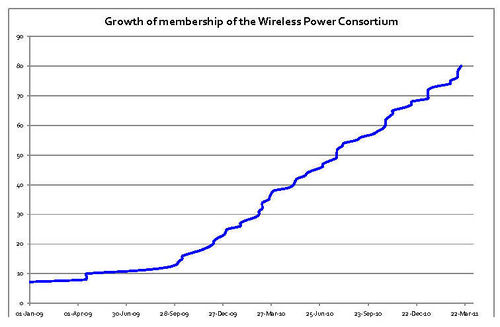
- The Wireless Power Consortium (WPC) is a cooperation of Asian, European and American companies from diverse industries that set out to provide universal compatibility across rechargeable devices.
- The WPC created Qi as the international standard for interoperable wireless charging of devices needing up to 5W of power. The WPC requires standardized testing and certification to be able to say a product is Qi compliant. A universal–or open–standard means you will be able to charge any Qi-enabled devices regardless of manufacturer.
- ABB is not a part of WPC, thus it would be a concern for the company as, in future the standard, though not mandatory, but can become a screening criteria used by the customers.
Radio frequency (RF) – Safety Concern.
- Human safety is protected by the Federal Communications Commission (FCC) and other agencies.
- However, new technologies require reevaluation to assure that the regulations accurately cover all concerns appropriately. Most regulations essentially can be analyzed in humans as limiting the temperature rise in the eye to less than 0.5°C in the eye.
- The human eye has been shown to be the most sensitive part of the human body to temperature rise due to RF.
- Also, having limits for RF safety is a related but separate issue from what is required to show compliance to those limits. Absence of test standards can slow regulatory approval for new types of devices and creates uncertainty about their compliance with requirements. That uncertainty could potentially manifest itself into business risk.
Biological Safety
Beyond human safety is a concern for the biological safety of other living organisms. These topics have been far less studied and therefore represent a relatively unknown business risk. Environmental impact is also a relatively unstudied area and an area in which future findings could have an adverse impact on WPT.
Interference with other Electronic Equipment
RF interference with other electronic equipment is another area business issue. A particular and important subset of the RF interference issue is the potential for there to be interference with medical equipment. Implanted medical devices such as pacemakers are one particular area to be evaluated. The risk here is that WPT could induce currents creating a shock or a spark hazard. WPT that creates significant magnetic fields would be of concern for equipment, such as HDD (Hard Disk Drives), credit cards or other devices using magnetic strips because of the potential impact from magnetic fields.
Wireless Power Applications
Sources
Pike Research Richard Martin and Clint Wheelock, 4Q 2010
Revenue Forecast by IHS iSuppli May 2011
ECCE,2011-IEEE Energy Conversion Congress & Exposition Sept. 2011
Wireless Power Transmission-Next Generation Power Transmission System


